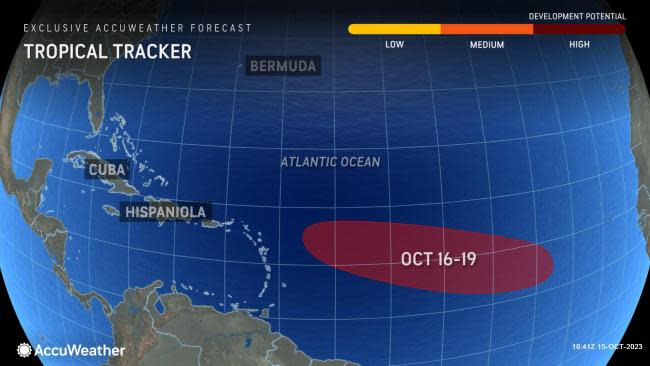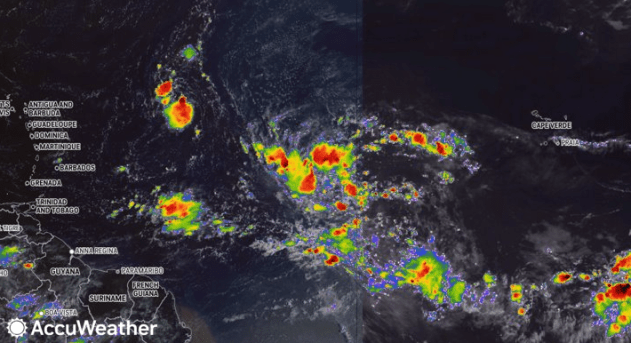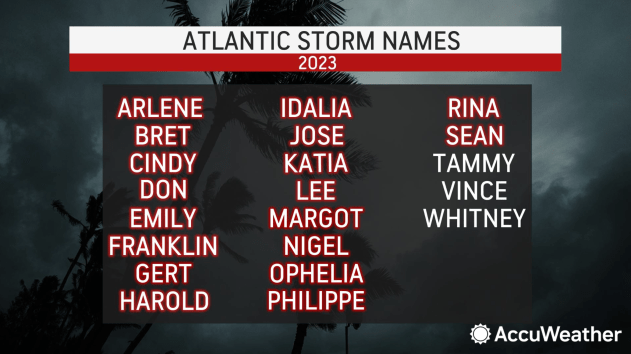Sean dissipates in the Atlantic, but could Tammy soon follow?
AccuWeather hurricane experts continue to monitor activity in the tropical Atlantic, which includes a new cluster of storms which could soon become the season's 19th named storm.
The next tropical storm to develop will be given the name Tammy. With about a month and a half left in the 2023 Atlantic hurricane season, only two names would remain on the list of storm names to be used in the Atlantic basin if Tammy forms, prompting questions about what would happen if another storm forms after the list is exhausted.
 |
AccuWeather Enhanced RealVue™ Satellite view of the central Atlantic captured on Monday, Oct. 16, 2023, shows a budding tropical wave. |
Over the central Atlantic, a tropical wave that moved off the western coast of Africa last week bears watching as it moves toward the Caribbean, say AccuWeather meteorologists.
A tropical wave is an area of low pressure that tracks westward from Africa into the Atlantic, which can organize into a tropical system when conditions are ripe. It appears that this will be the case with this wave, which is expected to become better organized this week, amid warm ocean waters and little wind shear.
There is a high chance of tropical development in the time frame from Oct. 18 to 20 as the tropical wave in the central Atlantic tracks to the west.
 |
In the event that a tropical storm forms, it would become Tammy, the 19th named storm of the season. Initially, it should take a similar track to Sean because the steering flow in the Atlantic should remain in a steady state through midweek. However, later in the week into the weekend, a pair of options appear to be on the table, according to AccuWeather hurricane experts.
A sprawling area of high pressure over the northern Atlantic will be key to steering any storm. Depending on its exact location, the storm could either stay farther south and move toward the Lesser Antilles or take a turn to the north and remain out at sea.
Any impacts in the eastern Caribbean islands would occur late this week or this weekend but only if the storm survives the trek.
In an average Atlantic hurricane season, 14 storms form in the basin, and they are named based on a rotating list of 21 names. So far, the 2023 season has been above the historical average with 18 named storms. Because of that, names on the list are being quickly exhausted.
 |
Previously, such as during the busy 2005 and 2020 Atlantic hurricane seasons, the Greek alphabet was utilized for any named storms after the 21st, or 'W,' storm. In 2021, the World Meteorological Organization (WMO), an arm of the United Nations, formally dropped the use of the Greek alphabet and adopted a supplemental list of another 21 names that can be tapped into, if necessary.
That list of predetermined names is also in alphabetical order, beginning with 'Adria,' according to the WMO.
The Atlantic hurricane season begins every year on June 1 and runs until Nov. 30. Storms can and have formed outside of the formally designated season, including this season in mid-January, when an unnamed subtropical storm was designated after the fact by the National Hurricane Center in July.
Want next-level safety, ad-free? Unlock advanced, hyperlocal severe weather alerts when you subscribe to Premium+ on the AccuWeather app. AccuWeather Alerts™ are prompted by our expert meteorologists who monitor and analyze dangerous weather risks 24/7 to keep you and your family safer.






